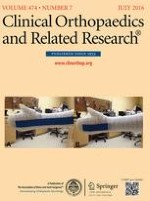Published in:

01-07-2016 | Symposium: Proceedings of the 2015 Musculoskeletal Infection Society
Is Vancomycin-only Prophylaxis for Patients With Penicillin Allergy Associated With Increased Risk of Infection After Arthroplasty?
Authors:
Timothy L. Tan, MD, Bryan D. Springer, MD, John A. Ruder, MD, Michael R. Ruffolo, MD, Antonia F. Chen, MD, MBA
Published in:
Clinical Orthopaedics and Related Research®
|
Issue 7/2016
Login to get access
Abstract
Background
Preoperative antibiotic prophylaxis remains one of the most important strategies for prevention of postoperative infection. In patients with penicillin allergy, alternative medications such as vancomycin are often used despite reduced antimicrobial coverage and recent literature questioning the efficacy of vancomycin monotherapy.
Questions/purposes
(1) Are patients who receive vancomycin alone for penicillin allergy at greater odds of developing surgical site infection (SSI) as compared with patients who receive cefazolin for prophylaxis before total joint arthroplasty (TJA) without a patient-reported allergy? (2) What organism profile is associated with vancomycin monotherapy?
Methods
We performed a retrospective study of 10,391 primary TJAs performed between 2005 and 2014 at two institutions with a minimum of 1-year followup. Patients reporting penicillin or cephalosporin allergy were electronically queried from the anesthesia note. The odds of deep SSI and causative organisms were compared using multivariate analysis between β-lactam-allergic patients receiving vancomycin and nonallergic patients receiving cefazolin.
Results
After controlling for potential confounders, including comorbidities, we found that vancomycin alone did not affect the odds of deep SSI development (adjusted odds ratio [OR], 0.98; 95% confidence interval [CI], 0.67–1.43; p = 0.907). Although the overall odds of deep SSI were not different for patients receiving vancomycin versus cefazolin, we found that vancomycin was associated with a reduced risk of infection with Gram-positive organisms (adjusted OR, 0.25 [CI, 0.10–0.62]; p = 0.003) and antibiotic-resistant organisms (adjusted OR, 0.10 [CI, 0.01–0.88]; p = 0.038). Vancomycin also demonstrated an increased risk of Gram-negative infection in bivariate analysis (OR, 2.42 [CI, 1.01–5.82]; p = 0.049) compared to cefazolin.
Conclusions
With the numbers available, vancomycin alone during elective primary TJA does not seem to result in a higher rate of subsequent deep SSI. However, patients who received vancomycin alone demonstrated reduced odds of Gram-positive organisms and methicillin-resistant Staphylococcus aureus. Vancomycin monotherapy can be used without increasing the risk of deep SSI; however, it should only be used in patients who require vancomycin, eg, anaphylactic reactions to penicillin resulting from the potential for the emergence of organism resistance and nephrotoxicity. Future studies are needed that use registry and large database studies to refute or confirm the preliminary findings of this study and determine if vancomycin monotherapy influences the risk of periprosthetic joint infection.
Level of Evidence
Level III, therapeutic study.





